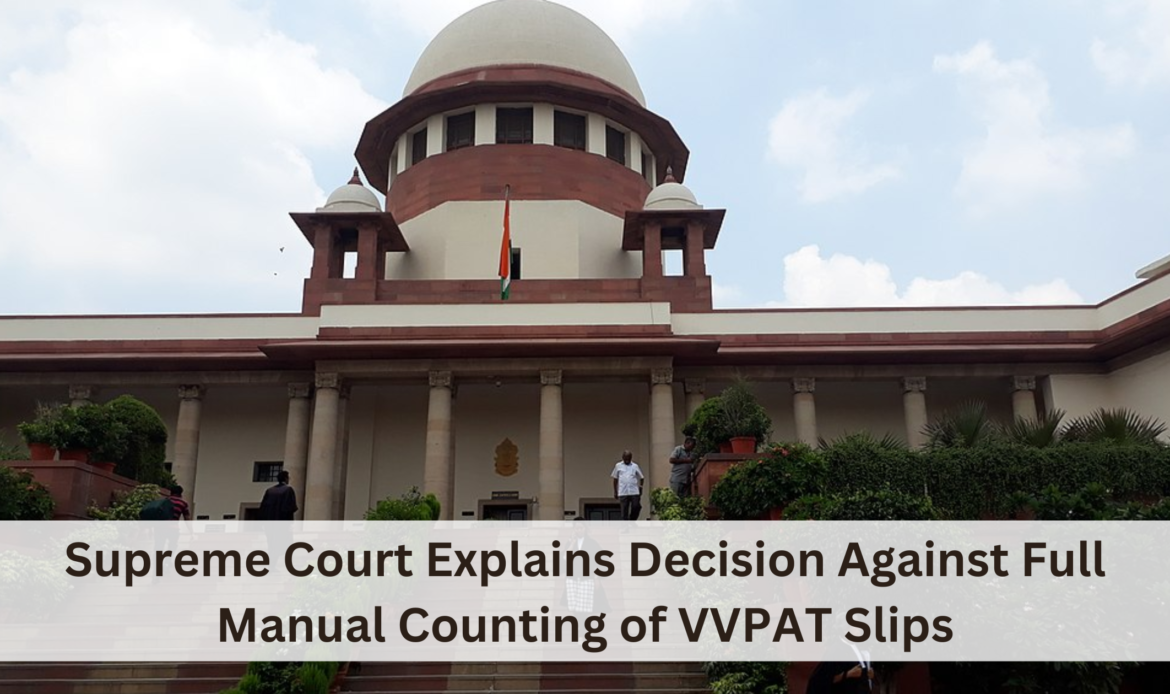In a significant ruling, the Supreme Court has made a decision regarding the Voter Verified Paper Audit Trail slips. The SC has declined requests to mandate a full manual counting of VVPAT slips during elections.
During the decision, the SC cited various operational and logistical challenges. The decision was rendered by a bench comprising Justices Sanjiv Khanna and Dipankar Datta. They delivered separate but concurring judgments on the matter.
Key Points of the Verdict
The court rejected petitions seeking a 100% cross-verification of Electronic Voting Machine (EVM) data with VVPAT records. This maintains the current system of randomly verifying 5% of EVMs per assembly segment within a parliamentary constituency. Several reasons were cited for this decision, including:
- Time and Delay: Full manual counting of VVPAT slips was deemed impractical due to the significant increase in time required for counting, potentially leading to delays in result declarations.
- Manpower Concerns: Doubling the manpower for manual counting was considered unfeasible and resource-intensive.
- Risk of Errors and Manipulation: Manual counting was highlighted as susceptible to human errors and potential manipulation, which could undermine the electoral process.
Justice Khanna, in his judgment, emphasized that no mismatches between EVM and VVPAT records had been detected during the 5% verification process mandated by previous rulings. This lack of discrepancy led the court to question the necessity of a full-scale manual counting exercise.
Fundamental Rights vs. Practical Limitations
The court drew a distinction between a voter’s fundamental right to accurate vote counting and the practical limitations of implementing a 100% manual VVPAT count. While acknowledging the importance of ensuring vote accuracy, the court clarified that this right does not equate to a demand for physical access to all VVPAT slips.
The ruling highlighted that administrative feasibility and the absence of substantial evidence indicating past discrepancies were pivotal factors in denying the petitioners’ request.
Evolution of VVPAT Mechanism
The judgment revisited the genesis of the VVPAT mechanism. It traces its origins back to the landmark Subramanian Swamy v. Election Commission of India (2013) case. In that case, the Supreme Court mandated the introduction of VVPATs to ensure transparency in elections.
Subsequent developments, including the N. Chandrababu Naidu v. Union of India case in 2019, saw an increase in the mandated random verification of VVPAT slips from 1 to 5 per assembly constituency or segment.
Future Considerations
In response to suggestions from the petitioners, the court advised the Election Commission of India (ECI) to explore the feasibility of using counting machines for VVPAT slips instead of relying solely on manual counting.
This technological consideration aims to streamline the verification process while ensuring accuracy and efficiency. The verdict underscores the delicate balance between electoral transparency and practical implementation. This emphasizes the need for evidence-based decisions in electoral procedures.
Final Words
As the SC has declined the plea to mandate manual counting of VVPAT slips, it’s a significant decision. This represents a nuanced approach to electoral integrity. It leverages technological advancements to address operational challenges while upholding the fundamental rights of voters.
Subscribe To Kshetry and Associates Newsletter for more legal updates.

